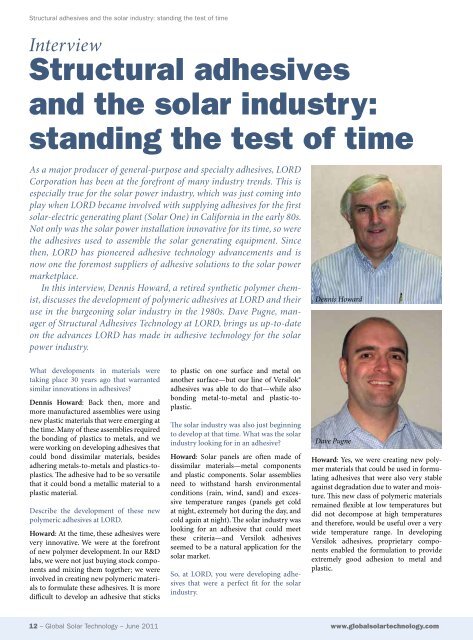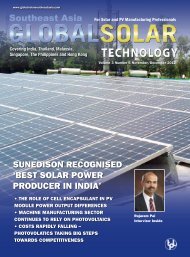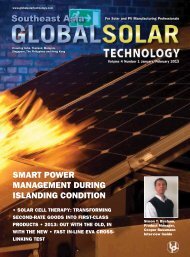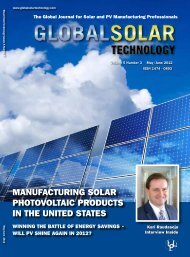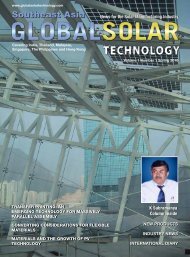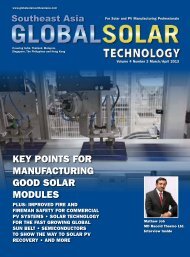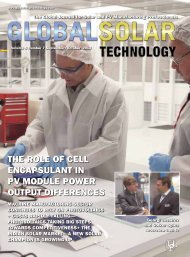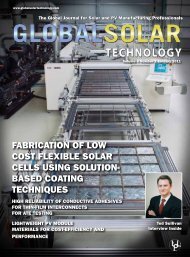download the PDF - Global Solar Technology
download the PDF - Global Solar Technology
download the PDF - Global Solar Technology
- No tags were found...
Create successful ePaper yourself
Turn your PDF publications into a flip-book with our unique Google optimized e-Paper software.
Structural adhesives and <strong>the</strong> solar industry: standing <strong>the</strong> test of timeInterviewStructural adhesivesand <strong>the</strong> solar industry:standing <strong>the</strong> test of timeAs a major producer of general-purpose and specialty adhesives, LORDCorporation has been at <strong>the</strong> forefront of many industry trends. This isespecially true for <strong>the</strong> solar power industry, which was just coming intoplay when LORD became involved with supplying adhesives for <strong>the</strong> firstsolar-electric generating plant (<strong>Solar</strong> One) in California in <strong>the</strong> early 80s.Not only was <strong>the</strong> solar power installation innovative for its time, so were<strong>the</strong> adhesives used to assemble <strong>the</strong> solar generating equipment. Since<strong>the</strong>n, LORD has pioneered adhesive technology advancements and isnow one <strong>the</strong> foremost suppliers of adhesive solutions to <strong>the</strong> solar powermarketplace.In this interview, Dennis Howard, a retired syn<strong>the</strong>tic polymer chemist,discusses <strong>the</strong> development of polymeric adhesives at LORD and <strong>the</strong>iruse in <strong>the</strong> burgeoning solar industry in <strong>the</strong> 1980s. Dave Pugne, managerof Structural Adhesives <strong>Technology</strong> at LORD, brings us up-to-dateon <strong>the</strong> advances LORD has made in adhesive technology for <strong>the</strong> solarpower industry.Dennis HowardWhat developments in materials weretaking place 30 years ago that warrantedsimilar innovations in adhesives?Dennis Howard: Back <strong>the</strong>n, more andmore manufactured assemblies were usingnew plastic materials that were emerging at<strong>the</strong> time. Many of <strong>the</strong>se assemblies required<strong>the</strong> bonding of plastics to metals, and wewere working on developing adhesives thatcould bond dissimilar materials, besidesadhering metals-to-metals and plastics-toplastics.The adhesive had to be so versatilethat it could bond a metallic material to aplastic material.Describe <strong>the</strong> development of <strong>the</strong>se newpolymeric adhesives at LORD.Howard: At <strong>the</strong> time, <strong>the</strong>se adhesives werevery innovative. We were at <strong>the</strong> forefrontof new polymer development. In our R&Dlabs, we were not just buying stock componentsand mixing <strong>the</strong>m toge<strong>the</strong>r; we wereinvolved in creating new polymeric materialsto formulate <strong>the</strong>se adhesives. It is moredifficult to develop an adhesive that sticksto plastic on one surface and metal onano<strong>the</strong>r surface—but our line of Versilok®adhesives was able to do that—while alsobonding metal-to-metal and plastic-toplastic.The solar industry was also just beginningto develop at that time. What was <strong>the</strong> solarindustry looking for in an adhesive?Howard: <strong>Solar</strong> panels are often made ofdissimilar materials—metal componentsand plastic components. <strong>Solar</strong> assembliesneed to withstand harsh environmentalconditions (rain, wind, sand) and excessivetemperature ranges (panels get coldat night, extremely hot during <strong>the</strong> day, andcold again at night). The solar industry waslooking for an adhesive that could meet<strong>the</strong>se criteria—and Versilok adhesivesseemed to be a natural application for <strong>the</strong>solar market.So, at LORD, you were developing adhesivesthat were a perfect fit for <strong>the</strong> solarindustry.Dave PugneHoward: Yes, we were creating new polymermaterials that could be used in formulatingadhesives that were also very stableagainst degradation due to water and moisture.This new class of polymeric materialsremained flexible at low temperatures butdid not decompose at high temperaturesand <strong>the</strong>refore, would be useful over a verywide temperature range. In developingVersilok adhesives, proprietary componentsenabled <strong>the</strong> formulation to provideextremely good adhesion to metal andplastic.12 – <strong>Global</strong> <strong>Solar</strong> <strong>Technology</strong> – June 2011 www.globalsolartechnology.com


